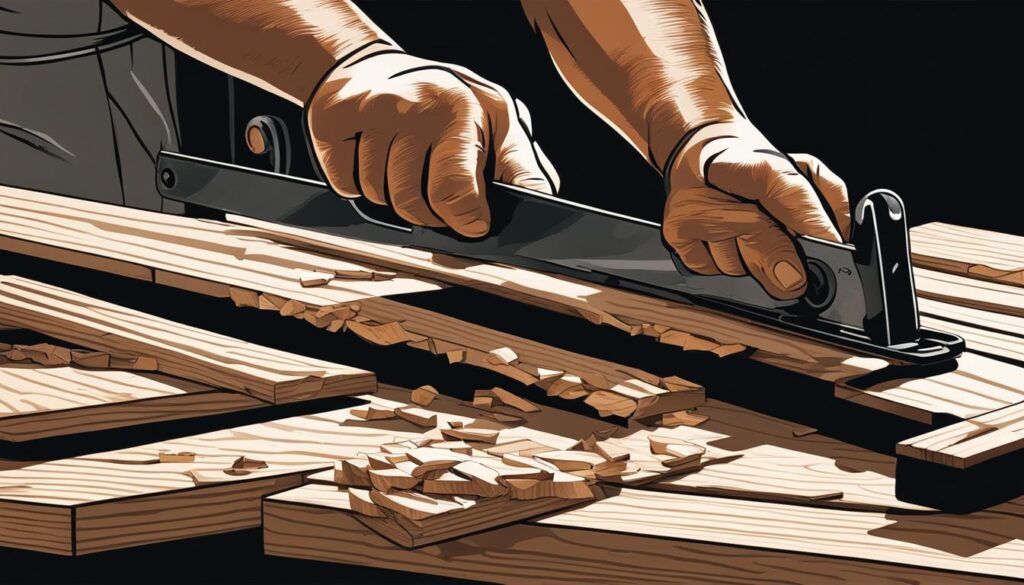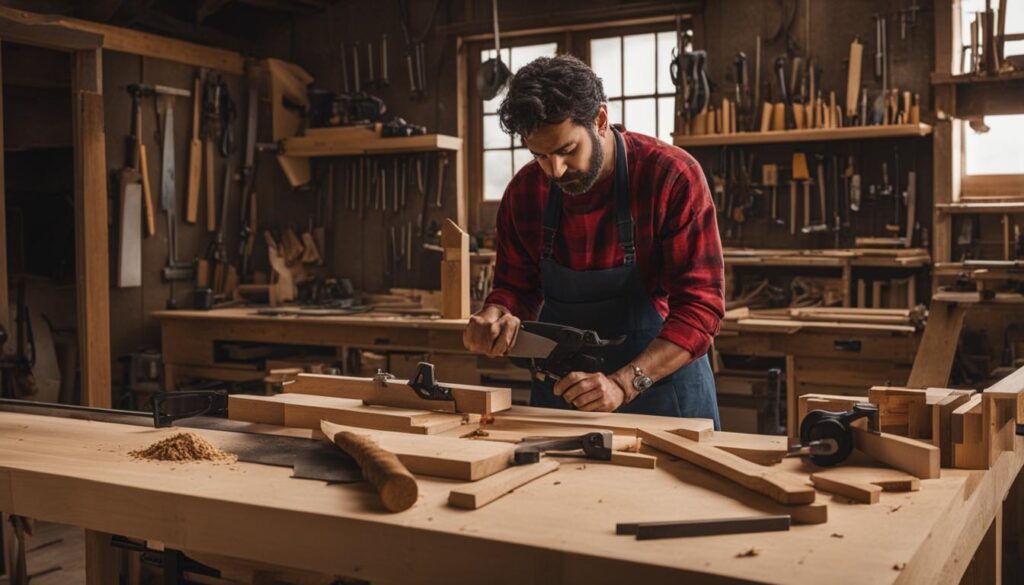We may earn money or products from the companies mentioned in this post.
If you’re a wood enthusiast, you know the joy of breathing new life into old, tired wood. Whether it’s a cherished family heirloom or a flea market find, the process of restoring wood is not only satisfying but also rewarding. To achieve professional-level results, you need the right wood restoration techniques, wood refinishing methods, and wood repair tips.
In this section, we will provide you with an ultimate guide to mastering wood restoration techniques. You’ll discover proven methods for preserving wood, enhancing your woodworking skills, and achieving spectacular results. From refinishing and repairing wood to restoring antique wood furniture, we have you covered.
Key Takeaways:
- Wood restoration techniques can breathe new life into old, tired wood.
- Proper wood preservation techniques can help protect your wood from future damage.
- Refinishing and repairing wood are essential aspects of wood restoration.
- Restoring antique wood furniture requires special care and attention.
- Whether you’re a DIY enthusiast or a professional woodworker, mastering wood restoration techniques can empower you to tackle any wood restoration project with confidence.
Understanding Wood Preservation Techniques
If you want to preserve the natural beauty and durability of wood, it’s crucial to understand the different wood preservation techniques available. From rejuvenating the surface to protecting it from future damage, here are the methods you need to know.
Wood Surface Rejuvenation
Over time, wood surfaces can become faded, stained, or cracked, causing them to lose their original beauty. However, with the right rejuvenation techniques, you can restore your wood surface to its former glory.
“Pro Tip: Before beginning the rejuvenation process, make sure to thoroughly clean the wood surface to remove any dirt, debris, or old finishes. This will ensure that the new finish adheres evenly to the surface.”
| Method | Description |
|---|---|
| Sanding | Smoothens the surface and removes old finishes or stains that have penetrated the wood. |
| Staining | Enhances the color and grain of the wood, creating a beautiful and uniform appearance. |
| Sealing | Protects the wood from moisture, UV rays, and other environmental factors, preventing it from deteriorating over time. |
Protecting Your Wood
To keep your wood in top condition, it’s essential to take preventative measures. By protecting your wood from future damage, you can extend its lifespan and maintain its natural beauty.
“Pro Tip: Always use protective gear, such as gloves, masks, and safety glasses, when applying any wood preservatives or finishes. This will help protect you from harmful chemicals and ensure your safety.”
- Regular cleaning: Cleaning the wood surface regularly, with a damp cloth or a gentle cleaning solution, removes any dust or debris that can cause damage over time.
- Weather protection: Protecting your wood from harsh weather conditions, such as rain, snow, or extreme heat, can prevent it from warping, cracking, or fading over time.
- Wood preservatives: Applying wood preservatives, such as sealants, stains, or anti-fungal treatments, protects the wood from moisture, insects, and other harmful organisms.
By mastering these wood preservation techniques, you can keep your wood in excellent condition, enhance its beauty, and extend its lifespan for years to come.
Refinishing and Repairing Wood
Refinishing and repairing wood are crucial aspects of wood restoration. Whether you have a vintage piece that needs a touch-up or a damaged furniture that needs repair, here are some proven methods to help you achieve the desired results.
Refinishing Methods
Refinishing wood involves sanding and staining the surface to restore its original look. Here are some methods to follow:
- Sanding: Start by sanding the surface with fine sandpaper to remove the old finish and smooth out any imperfections. Use a sanding block to ensure even pressure.
- Staining: Once the surface is sanded, apply a wood stain with a brush or rag to achieve the desired color. Wipe off any excess stain with a clean cloth.
- Finish: Finally, apply a clear coat or sealer to protect the surface from damage.
Repair Tips
Repairing damaged wood requires careful attention and precision. Here are some tips to follow:
| Problem | Solution |
|---|---|
| Cracks or Holes: | Fill the cracks or holes with wood filler, sand the surface, and refinish it with stain and a clear coat. |
| Loose Joints: | Apply wood glue to the joint and clamp it in place until the glue dries. Sand and refinish the surface if needed. |
| Water Damage: | Sand the damaged area until the stain is gone, apply a wood bleach solution to lighten the wood, let it dry, and refinish the surface. |
| Scratches: | Fill the scratches with wood filler, sand the surface, and refinish it with stain and a clear coat. |
By following these wood refinishing methods and wood repair tips, you can restore your wood furniture to its original beauty and maintain its quality for years to come.
Restoring Antique Wood Furniture
Antique wood furniture is a unique and valuable addition to any home. However, restoring these pieces requires special care and attention to preserve their original character and value. In this section, we will provide you with expert tips and techniques for restoring antique wood furniture.
Assessing the Condition of Your Antique Furniture
Before beginning the restoration process, it is essential to assess the current condition of your vintage furniture. Check for cracks, loose joints, missing parts, and any other damage that needs repair. Inspect the finish to determine if it needs to be cleaned, polished, or stripped entirely. Take note of any unique features or markings that make your piece distinctive and add to its value.
Removing Stains from Wood Furniture
Antique wood furniture is often prone to stubborn stains that can detract from its beauty. However, with the right technique, you can remove these stains and restore your furniture’s original beauty. Here’s how:
- Identify the type of stain and the type of wood to determine the appropriate cleaning solution.
- Test the chosen cleaning solution on a small, inconspicuous area of the furniture to avoid causing further damage.
- Apply the cleaning solution to the affected area using a soft cloth, working with the grain to avoid scratching the wood.
- Rinse the area thoroughly with a damp cloth and allow it to dry completely.
Reviving Faded Wood Finishes
Over time, the finish on antique furniture can fade and lose its luster. However, with the right tools and techniques, you can restore the original glow of your vintage piece. Here’s how:
- Clean the surface of the furniture using a soft cloth and a mild cleanser.
- Apply a small amount of a wood restorer product to a soft cloth, and then rub it onto the furniture surface in a circular motion.
- Remove any excess product with a clean cloth and allow the surface to dry completely.
- Apply a high-quality furniture wax to seal and protect the restored finish.
Preserving the Original Character of Your Antique Furniture
The original character of your antique furniture is what makes it unique and valuable. When restoring your vintage piece, it is important to preserve these original characteristics. Here are some tips:
- Avoid over-sanding and over-staining the wood, as this can alter the original color and texture of the wood.
- Use minimal amounts of filler to repair damaged areas, as excessive filling can also alter the original shape of the furniture.
- Retain any unique features or markings that add to the value and history of your piece.
Restoring antique wood furniture requires patience, skill, and attention to detail. However, with these expert tips and techniques, you can revive the beauty and value of your vintage pieces and enjoy them for years to come.
Conclusion
Now that you have learned about various wood restoration techniques, it’s time to put your knowledge into practice. Whether you’re a DIY enthusiast or a professional woodworker, there’s always room to improve your skills.
DIY Wood Restoration
If you’re planning to restore wood by yourself, make sure you have the right tools and materials. Take your time and follow the instructions carefully. Don’t rush the process, as haste can lead to mistakes that may be difficult to fix later. Don’t hesitate to seek help if you get stuck.
Professional Wood Restoration
If you’re looking for professional wood restoration, make sure you choose a reputable company with experienced and skilled technicians. Do your research, read reviews, and ask for references before hiring anyone. A professional wood restoration service can save you time and effort, while ensuring that your wood pieces receive the highest quality treatment.
Regardless of whether you choose the DIY or professional route, remember that wood restoration is an art that requires patience, skill, and attention to detail. With practice and persistence, you can master the techniques and bring new life to your wood pieces. Happy restoring!
FAQ
What are wood restoration techniques?
Wood restoration techniques involve various methods for reviving, refinishing, repairing, and preserving wood surfaces. These techniques can be used to restore antique furniture, refinish worn-out wood, and repair damaged areas.
Why is wood preservation important?
Wood preservation is crucial for protecting wood surfaces from damage caused by moisture, pests, and exposure to the elements. It helps to prolong the lifespan of wood and maintain its natural beauty.
What are some common wood refinishing methods?
Common wood refinishing methods include sanding, staining, and applying a protective finish such as varnish or lacquer. These methods help to enhance the appearance of wood and protect it from wear and tear.
How can I repair damaged wood?
To repair damaged wood, you can use techniques such as filling cracks with wood filler, fixing loose joints with adhesive, or replacing damaged sections with new wood. It’s important to assess the extent of the damage and choose the appropriate repair method.
How do I restore antique wood furniture?
Restoring antique wood furniture requires careful cleaning, removing stains, repairing any damage, and applying appropriate finishes. It’s important to use gentle methods and preserve the original character of the piece while enhancing its beauty.
Affiliate Disclosure: This post may contain affiliate links. If you purchase through our link, we may receive a small commission, but at no additional cost to you. For more information, please see our Disclosure statement.



